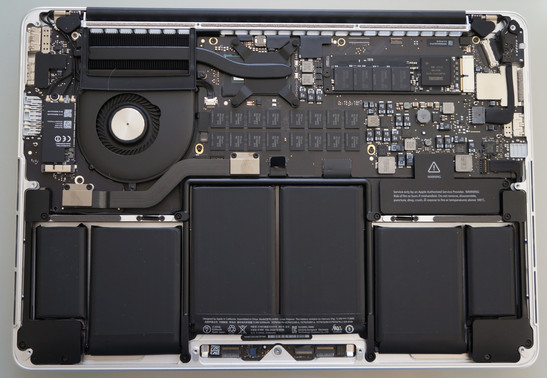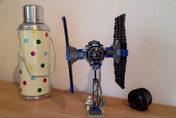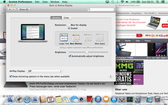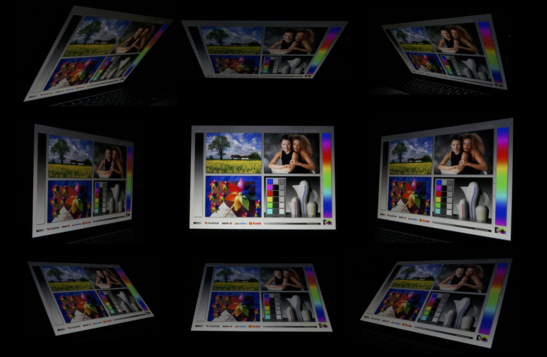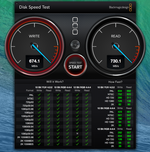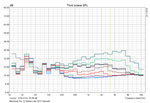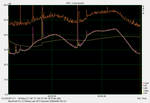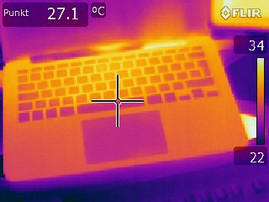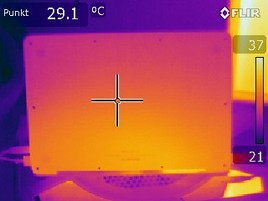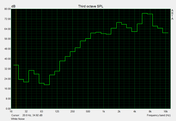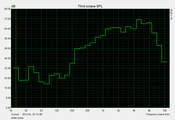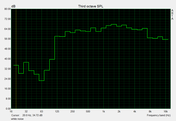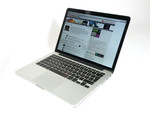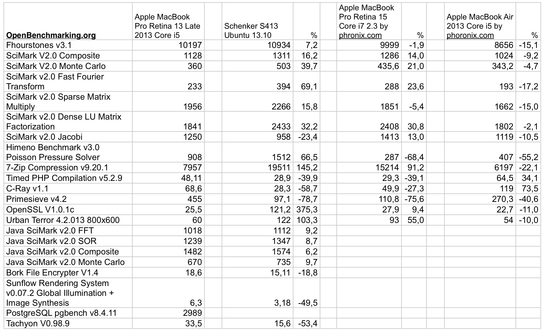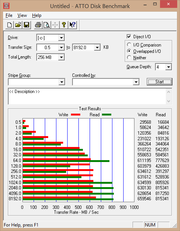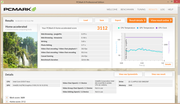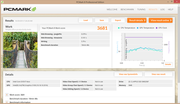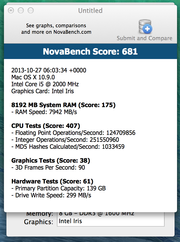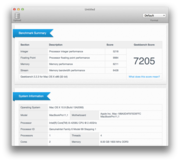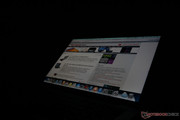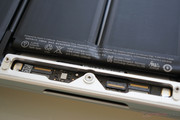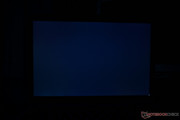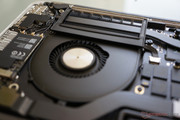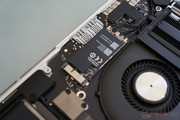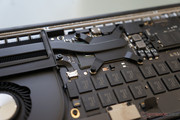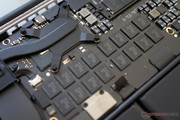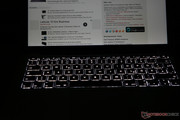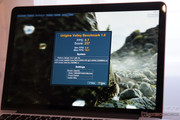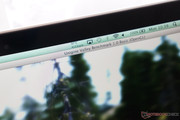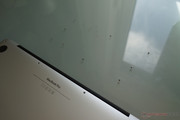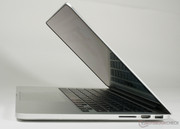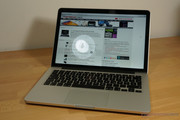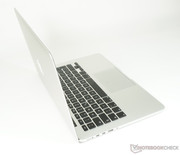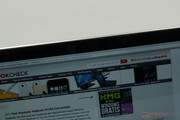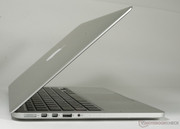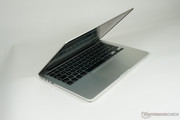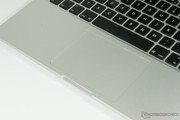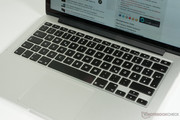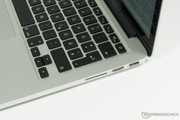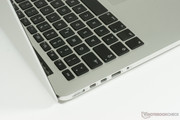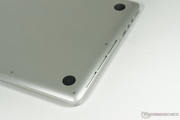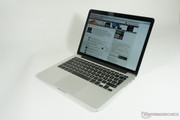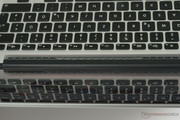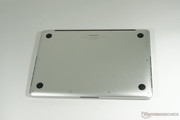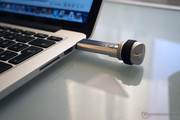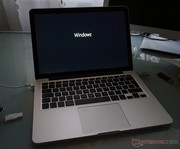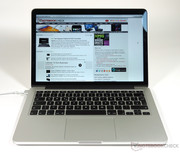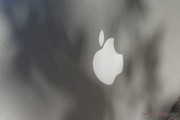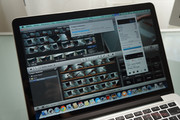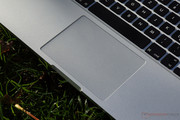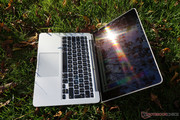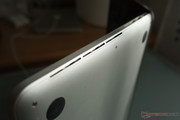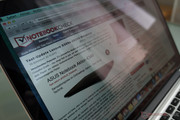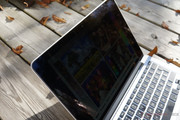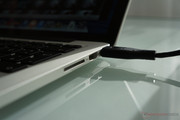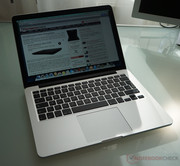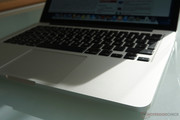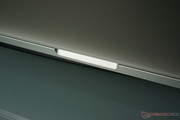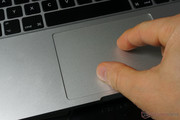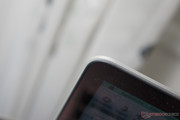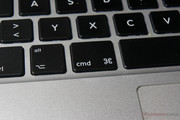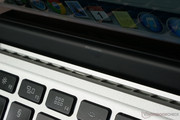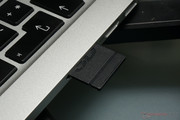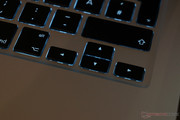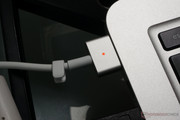Review Apple MacBook Pro Retina 13 Late 2013 Notebook

For the original German review, see here.
The Haswell update of the 13-inch MacBook Pro Retina does not only include new components. Apple was also able to reduce the thickness of the case from 19 mm to 18 mm thanks to the reduced energy consumption of the platform. That is not a big difference to the 17 mm of the 13-inch MacBook Air, but the case does not get thinner towards the front.
| MacBook Pro 13 Retina 2013 | MacBook Pro 13 Retina 2012 | MacBook Air 13 | MacBook Pro 15 Retina | |
|---|---|---|---|---|
| Weight | 1.57 kg / 3.46 lbs | 1.62 kg / 3.57 lbs +3% | 1.35 kg / 2.96 lbs -14% | 2.02 kg / 4.46 lbs +29% |
| Height | 18 mm | 19 mm | 17 mm | 18 mm |
| Width | 31.4 cm | 31.4 cm | 32.5 cm | 35.9 cm |
| Depth | 21.9 cm | 21.9 cm | 22.7 cm | 24.7 cm |
Our review unit is the configuration with a Core i5-4258U processor, 256 GB SSD and 8 GB RAM. Our review unit was not provided by Apple, we just bought it in the online store.
With the low weight and the thin case, the MacBook Pro 13 is clearly a subnotebook, but its powerful processor stands out from the competition in this class.
Case
Despite the new case, the design of the 13-inch Retina is completely unchanged from its predecessor. It is also quite hard to find any ways to improve it. The unibody chassis is still made from a single piece of aluminum and can convince us with its high stability, high-quality haptics and design as well as the perfect build quality. Only the sharp edge of the palm rest is not perfect from an ergonomics point of view. However, this is not a serious drawback thanks to the low height of the case.
Connectivity
Compared to other manufacturers, Apple chose a different path in regard to the port equipment, as usual. One characteristic feature is the two Thunderbolt 2 ports, which can also be used as a mini DisplayPort. Contrary to the predecessor, we now get a faster Thunderbolt controller. The port equipment is identical to the larger 15-inch version, while the latest MacBook Air 13 lacks both HDMI and the second Thunderbolt port. All three video ports can be used for high-resolution displays (according to Apple, we only tested mini DisplayPort with one 2560x1440 27-inch display) and the GPU can handle three individual displays simultaneously. This is a clear advantage over most Windows notebooks that usually only offer two digital video ports. However, you will have to live without a third USB port as well as an Ethernet port in return.
Communication
The MacBook Pro Retina only supports the wireless standards 802.11 b/g/n/ac (2.4 and 5 GHz) and Bluetooth 4.0. Ethernet is only available with a USB or Thunderbolt adaptor. 3G / 4G or LTE is only available via Bluetooth, WLAN or USB Tethering (USB Tethering with Android only via third party drivers like HoRNDIS).
We could only determine the WLAN performance in combination with a Linksys E4200 802.11n router. The new AC standard is supported by the Retina, however, you obviously need a compatible wireless router. Our comparison also includes a MacBook Pro from 2010 and a Schenker S413 (Clevo W740SU) besides the review unit. As expected, the connection was very good but slightly fluctuating with a distance of 1 meter (~ 3.3 feet) and in direct sight. According to iperf, the best result was 297 Mbps, but we also saw results below the old MBP 13, which managed 207 Mbps. Schenker's S413 was the slowest device with just 156 Mbps, despite Intel's new AC WLAN module. The attached AMD A8-5600K desktop (LAN) with an Asus F2A85-V did not affect the performance; we could see the maximum transfer rate of 865 Mbps when we attached the Schenker via Ethernet.
One floor below (concrete ceiling and a partition wall), the performance of the Retina was reduced to 42 Mbps. MBP 13 and S413 were significantly faster with 59 Mbps and 55 Mbps, respectively.
We performed the third test in the concrete basement (two floors and some partition walls), where weak WLAN modules / antennas often lose the connection. The Retina Mac also struggled a bit and only managed the 7.4 Mbps with three lost packages (of 60). The Schenker took second place with 13.8 Mbps without losses behind the old MBP with 15.6 Mbps.
All in all, not the best performance in a wireless-n network, but also better than many notebooks with cheap WLAN modules. Both the range and the speed should be better in an 802.11 ac network, but that also applies for the Schenker S413.
Warranty
Apple only grants a 12-month warranty for the device. The additional price for 3 years including phone support (Apple Care) is rather expensive at $249.
Maintenance
This is not really the strong suit of the Retina MacBook Pro. It is actually quite easy to access the components since you can remove the bottom cover. However, Apple uses proprietary pentalobe screws to secure the cover. After loosening the screws, you quickly gain access to the fan, SSD and WLAN module. The battery is unfortunately glued (and prevents easy access to the touchpad). Memory and processor are soldered onto the mainboard, so a repair would be very expensive. The notebook got a very low score from iFixit (1 out of 10 points).
FaceTime HD Webcam
The integrated 720p FaceTime HD webcam is still one of the drawbacks. The performance is average for video calls, but we certainly expect more from Apple because of their emphasis on iMessage and video calls. The voice quality on the other hand was excellent thanks to the two microphones.
Input Devices
Keyboard
The excellent chiclet keyboard with background illumination remained unchanged. Haptics, feedback and key size are great and we managed the same typing speed as with a mechanical Cherry MX 3000 (86 words per minute) right away. One small drawback is the minimalistic lettering ("Where is the damn tilde?") and especially Windows users will have some problems because of the different key assignments (@,{}.[]).
Touchpad
Apple's multi-touch glass touchpad is still the benchmark. The combination of a smooth glass surface, convenient pressure point, precise execution and smart drivers under OS X is more or less unrivaled in the Windows world. Here we can see the result of the close relationship between software and hardware. Scrolling, zooming and swiping work flawlessly and without any apparent problems. The only drawback is the sharp edge at the front of the touchpad.
After one week, we also encountered keyboard and trackpad issues. The problem is therefore quite rare, but the resulting waiting period of around one minute in stand-by is rather annoying.
Display
The glossy 13-inch display has a resolution of 2560x1600 pixels in the already disappearing 16:10 ratio. The actual screen space matches the 1280x800 resolution with the standard settings, but texts and icons are obviously much sharper (with Retina-ready apps). The apparent advantage of this solution is that even old applications can be used without adjustments; they just don't look as nice. This is a big problem under Windows with its DPI scaling. Our tests with Boot Camp often revealed very small and hardly readable texts (older 3D Mark or X-Rite software) and overlapping elements (check boxes in Fraps). You can also select up to 1680x1050 pixels (scaled) - with minimal loss of quality (not as bad as the wrong resolution, for instance).
Unfortunately, we saw some fluctuations with our brightness measurements since Windows 8.1 still has some issues with the brightness sensor. The results in OS X were slightly better than the results in Windows with a maximum brightness of 388 cd/m² and a black value of 0.4 cd/m². The contrast ratio of 970:1 is very good and our subjective impression of the display is also very good.
| |||||||||||||||||||||||||
Brightness Distribution: 81 %
Center on Battery: 360 cd/m²
Contrast: 900:1 (Black: 0.4 cd/m²)
ΔE ColorChecker Calman: 1.87 | ∀{0.5-29.43 Ø4.78}
ΔE Greyscale Calman: 2.19 | ∀{0.09-98 Ø5}
63% AdobeRGB 1998 (Argyll 1.6.3 3D)
Gamma: 2.58
CCT: 6688 K
| |||||||||||||||||||||||||
Brightness Distribution: 84 %
Center on Battery: 327 cd/m²
Contrast: 779:1 (Black: 0.42 cd/m²)
The color accuracy of our review unit is excellent, even without a calibration. The DeltaE deviations in the ColorChecker test are the lowest we ever measured. Therefore, the human eye should not see any differences between the displayed and the real color. Results for the grayscale presentation are not as good, but our i1Pro 2 measuring tool is less accurate at lower brightness settings. The sRGB color space is completely covered by the Retina display.
Some of the following measurements were only taken in Windows 8.1 since the X-Rite software did not recognize our i1Pro 2 in OS X (this is also the reason for the brightness differences between chart and text).
A calibration with the X-Rite software improves the results even further, so the display should be well suited for demanding picture editing.
Thanks to the high maximum brightness, you can use the device outdoors, despite the glossy display surface. Reflections are also reduced by a red hue; it seems that Apple uses some kind of anti-reflective coating. Compared to the old MacBook Pro 13 there is no more protective glass cover, and there are no more double reflections as a result.
Display Response Times
| ↔ Response Time Black to White | ||
|---|---|---|
| 26.2 ms ... rise ↗ and fall ↘ combined | ↗ 5.2 ms rise | |
| ↘ 21 ms fall | ||
| The screen shows relatively slow response rates in our tests and may be too slow for gamers. In comparison, all tested devices range from 0.1 (minimum) to 240 (maximum) ms. » 65 % of all devices are better. This means that the measured response time is worse than the average of all tested devices (20.2 ms). | ||
| ↔ Response Time 50% Grey to 80% Grey | ||
| 33 ms ... rise ↗ and fall ↘ combined | ↗ 15 ms rise | |
| ↘ 18 ms fall | ||
| The screen shows slow response rates in our tests and will be unsatisfactory for gamers. In comparison, all tested devices range from 0.165 (minimum) to 636 (maximum) ms. » 44 % of all devices are better. This means that the measured response time is similar to the average of all tested devices (31.6 ms). | ||
Screen Flickering / PWM (Pulse-Width Modulation)
| Screen flickering / PWM not detected | ||
In comparison: 53 % of all tested devices do not use PWM to dim the display. If PWM was detected, an average of 8095 (minimum: 5 - maximum: 343500) Hz was measured. | ||
Windows 8.1 via Boot Camp
The Boot Camp installation was not trivial in our test. We also had the problem that we could not install Windows right away (see Apple Discussions). We were finally successful with a Win 8.1 Trial (via ISO) on a new USB stick. The driver support is still far from perfect, the touchpad, for instance, does not support Windows 8 gestures and the brightness control did not work properly. Finally, the resolution scaling in Windows cannot keep up with OS X, but this is not only a problem of the MacBook.
Performance
Intel significantly improved the performance of the integrated GPU with the Haswell generation. These are perfect conditions, especially for the MacBook Pro 13 Retina. The old version from 2012 suffered from the weak HD Graphics 4000 of the Ivy Bridge architecture and the situation is much better in the current Retina version. Websites and applications were very smooth in our tests.
Processor
The integrated Core i5-4258U only has an advantage of 4-9% over the Core i5-3210M from 2012. The Zenbook UX301 with the i7-4558U, which is also available for the Retina, has an advantage of more than 10% on average.
A comparison between Windows 8.1 and OS X Mavericks favors Windows in all of our Cinebench versions, except for CB 10 (even though the 64-bit version is still faster under Windows).
| Cinebench R10 | |
| Rendering Single 32Bit (sort by value) | |
| MBP Retina 13 2013 OS X | |
| MBP Retina 13 2013 Win 8.1 | |
| MBP Retina 13 2012 | |
| MBP Retina 15 2012 | |
| MB Air 11 i7 | |
| Zenbook UX301LA i7 | |
| Rendering Multiple CPUs 32Bit (sort by value) | |
| MBP Retina 13 2013 OS X | |
| MBP Retina 13 2013 Win 8.1 | |
| MBP Retina 13 2012 | |
| MBP Retina 15 2012 | |
| MB Air 11 i7 | |
| Zenbook UX301LA i7 | |
| Cinebench R11.5 | |
| CPU Single 64Bit (sort by value) | |
| MBP Retina 13 2013 OS X | |
| MBP Retina 13 2013 Win 8.1 | |
| MBP Retina 13 2012 | |
| MBP Retina 15 2012 | |
| MB Air 11 i7 | |
| Zenbook UX301LA i7 | |
| CPU Multi 64Bit (sort by value) | |
| MBP Retina 13 2013 OS X | |
| MBP Retina 13 2013 Win 8.1 | |
| MBP Retina 13 2012 | |
| MBP Retina 15 2012 | |
| MB Air 11 i7 | |
| Zenbook UX301LA i7 | |
| Cinebench R15 | |
| CPU Single 64Bit (sort by value) | |
| MBP Retina 13 2013 OS X | |
| MBP Retina 13 2013 OS X | |
| MBP Retina 13 2013 Win 8.1 | |
| CPU Multi 64Bit (sort by value) | |
| MBP Retina 13 2013 OS X | |
| MBP Retina 13 2013 OS X | |
| MBP Retina 13 2013 Win 8.1 | |
System Performance
Thanks to the fast SSD and the powerful mainstream Haswell CPU, the PCMark result of the Retina MacBook Pro 13 is very good. It is basically on the same level with the 2012 Retina MacBook Pro 15 with dedicated graphics.
| PCMark 7 Score | 5460 points | |
| PCMark 8 Home Score Accelerated | 3112 points | |
| PCMark 8 Creative Score Accelerated | 3297 points | |
| PCMark 8 Work Score Accelerated | 3681 points | |
Help | ||
| Geekbench 2 - 32 Bit - Total Score (sort by value) | |
| MacBook Pro Retina 13 2013 OS X | |
| MacBook Pro Retina 13 2013 Win 8.1 | |
| MacBook Air 13 OS X 10.8 | |
| Zenbook UX301 | |
Storage Solution
Similar to the Haswell based MacBook Airs, Apple also equips the new Retina MacBook Pro 13 with a PCIe SSD. It provides significantly higher sequential transfer rates than single SSDs via SATA. This solution can even compete with larger and vulnerable RAID 0 configurations that can be found in the Asus Zenbook Infinity UX301LA, for example. The Apple SSD with the designation SM0256F uses a controller (S4LNO53X01-8030) and memory chips (K9HFGY8S5C-XCK0) from Samsung.
The AS SSD overall score shows that the Samsung SSD does not have to hide behind two SanDisk X110s (RAID 0) in the Zenbook UX301. The RAID configuration only managed a 16% higher score and only reached between 58% and 94% of the performance in the copy benchmark. A quick look at the results shows that Apple's solution is especially fast in sequential operations. Single 4K operations are however not the strong suit of the drive.
Despite this 4K problem, the Samsung SSD shows very good results in the Tracing benchmarks of PCMark 7 and 8 and can take a top spot in our charts.
| PCMark 7 - System Storage (sort by value) | |
| Apple MacBook Pro Retina 13 inch 2013-10 | |
| Apple MacBook Air 11 inch 2013-06 1.7 GHz 256 GB | |
| Apple MacBook Air 13 inch 2013 MD760D/A | |
| Apple MacBook Air 11 inch 2013-06 MD711D/A | |
| Apple MacBook Pro Retina 13 inch 2012-10 | |
| Apple MacBook Pro Retina 15 inch 2012-06 | |
| Asus Zenbook UX301 | |
Graphics
The integrated Intel Iris Graphics 5100 is the GT3 version of the Haswell GPU with all shaders, but without the dedicated memory from the Iris Pro 5200. The clock is dynamically adjusted between 200 and 1100 MHz via Turbo Boost. By the way, the Core i7 can use another 100 MHz with a maximum clock of 1200 MHz, which should result in a theoretical performance advantage with sufficient cooling.
Synthetic benchmarks under Windows 8.1 show the performance of the new GPU. The advantage over the HD 4400 (GT2), which is used in many ultrabooks, is impressive. Most review units only manage 70% of the performance and the difference to the old MBP Retina with Intel HD Graphics 4000 is huge. The 2012 Retina only managed 47% of the HD 5100's performance in the 3DMark 11 GPU Test for instance, however, 3DMark 11 is not really affected by memory bandwidth. The HD Graphics 5000 in the MacBook Air is based on the same core with lower clocks; the difference in 3DMark 2013 and 11 is only around 5%.
| 3DMark 11 - 1280x720 Performance GPU (sort by value) | |
| Apple MacBook Pro Retina 13 inch 2013-10 | |
| Apple MacBook Air 11 inch 2013-06 1.7 GHz 256 GB | |
| Apple MacBook Air 13 inch 2013 MD760D/A | |
| Apple MacBook Air 11 inch 2013-06 MD711D/A | |
| Apple MacBook Pro Retina 13 inch 2012-10 | |
| Apple MacBook Pro Retina 15 inch 2012-06 | |
| Asus Zenbook UX301 | |
| Sony Vaio Pro 13 SVP-1321C5ER | |
| Lenovo ThinkPad T440s 20AQ-S00500 | |
| 3DMark 06 Standard Score | 7474 points | |
| 3DMark 11 Performance | 1270 points | |
| 3DMark Ice Storm Standard Score | 39510 points | |
| 3DMark Cloud Gate Standard Score | 5286 points | |
| 3DMark Fire Strike Score | 863 points | |
Help | ||
Gaming Performance
The immediate rival when it comes to gaming performance under Windows is the Asus UX301, which was equipped with the more powerful Core i7-4558U and the same Iris Graphics 5100 in our review configuration. However, the i7 has a 100 MHz higher GPU clock with Turbo Boost. The gaming benchmarks show mixed results; the Asus was around 5-10% faster in FIFA and Company of Heroes 2, but also 5% slower in Tomb Raider and Total War: Rome II. These results can be affected by cooling, drivers, game patches since our review of the Asus or measuring tolerances. Generally speaking, the gaming performance in Windows is comparable.
Our benchmark site of the Iris Graphics 5100 shows that current games are usually only playable with lowest details.
We also tested two games in OS X Mavericks (via Steam). Left 4 Dead 2 was not completely smooth with 19 fps at 2560x1600 (maximum details), but a reduced resolution of 1280x800 improved the situation. Even Civilization V was playable and looked quite nice at 1280x800 with default settings (Medium / Low).
| low | med. | high | ultra | |
|---|---|---|---|---|
| Tomb Raider (2013) | 64.4 | 32.8 | 19.7 | 10.4 |
| Company of Heroes 2 (2013) | 18.5 | 15.2 | ||
| Total War: Rome II (2013) | 49 | 36.7 | 27.9 | 9.2 |
| Fifa 14 (2013) | 47.5 | |||
| F1 2013 (2013) | 60 | 38 | 29 | 15 |
| Batman: Arkham Origins (2013) | 44 | 25 | 14 | 7 |
| Battlefield 4 (2013) | 36.1 | 26.1 | 15 | 5 () |
| Call of Duty: Ghosts (2013) | 40.5 | 26.5 | 10.3 | 4.9 |
| Thief (2014) | 20.8 | 13.2 | 10.7 | 5.1 |
| The Elder Scrolls Online (2014) | 46 | 26.6 | 18.4 | 10.1 |
| low | med. | high | ultra | |
|---|---|---|---|---|
| Assassin´s Creed IV: Black Flag (2013) | 24 | 17.5 | 8.9 | 4.4 |
| GRID: Autosport (2014) | 94 | 34.6 | 21 | 12.5 |
| Risen 3: Titan Lords (2014) | 37.3 | 20.3 | 8.7 | 7.3 |
| Fifa 15 (2014) | 56 | 42 | 25.8 | |
| Middle-earth: Shadow of Mordor (2014) | 25 | 17.3 | 9.5 | 0 |
| Call of Duty: Advanced Warfare (2014) | 30.8 | 18.5 | ||
| Dragon Age: Inquisition (2014) | 24.3 | 17.3 | 6.3 | 3.5 |
| Evolve (2015) | 19.1 | 14.4 | ||
| Battlefield Hardline (2015) | 31.9 | 23.6 | 9.2 | 5.9 |
| Dirt Rally (2015) | 87 | 26 | 13.5 | |
| The Witcher 3 (2015) | 14.1 | |||
| Metal Gear Solid V (2015) | 37.2 | 24.9 | 9 | |
| Mad Max (2015) | 18.7 |
Video Performance
The Core i5-4258U has an integrated hardware decoder for H.264, WMV and VC-1 for videos with a resolution of up to 4K. Apple has unfortunately only used the decoder for H.264 in OS X. However, it worked flawlessly in our test. A 4K 100 Mbps H.264 sample video only results in minimal CPU load and we could not see any problems during playback. A 1080p H.264 video showed a similar CPU load, which confirms the use of the hardware decoder.
YouTube Flash videos were no problem for the MacBook Pro Retina, either. Even a 4K video did not show any dropped frames and CPU load was quite low.
VC-1 and WMV are not supported by the standard video player, so we installed the free VLC Player. Playback of 1080p videos in WEBM, WMV and VC-1 produced more CPU load but the playback was smooth. The 4K sample video on the other hand showed the limits of the CPU (full load, jerky playback), which is a sign of missing hardware support.
By the way, you can use the hardware decoder via DXVA-Hooks under Windows 8.1 (via Boot Camp) without restrictions.
Emissions
System Noise
Contrary to the old version, Apple only uses a single fan for the new 13-inch Retina. It can convince us with the silent operation; the fan works with inaudible 1200-1300 rpm according to smcFanControl. Our measurement tool cannot differentiate between the device and the ambient noise from a distance of 15 cm (27.3 dB / 0.93 sone). Light workloads did not increase the fan speed, even a 4K video, a YouTube 1080p video and several browser tabs did not change the situation.
We could only see higher speeds under load. A loop of Cinebench R15 Multicore Tests resulted in 1900 rpm at 27.5 dB(A) / 0.95 sone. This is only slightly audible if you put your ear right next to the fan exhaust.
Unigine Heaven Valley 1.0 with Ultra settings resulted in an audible fan noise at 4200 rpm with 36.2 dB(A) and 2.45 sone; still comparatively good results. The system noise is dominated by the air noise, which is very convenient. The maximum system noise under Mac OS X was 42.4 dB(A) / 4 sone with Unigine Valley and Cinebench R15 simultaneously.
The fan speeds during normal workloads are subjectively much higher under Windows 8.1. 3DMark 06 (see chart further below) even shows a maximum of 42.5 dB(A) (and therefore more than the maximum under Mac OS X). The noise leveled off at a clearly audible 44.5 dB(A) / 4.6 sone during FIFA 14, but the noise characteristic was still pleasant.
Our usual stress test with Prime95 and FurMark resulted in 5800 rpm and a loud 44.7 dB(A) / 4.8 sone. However, we could not reach the maximum fan speed (6199 rpm with 47.9 dB(A) and 5.9 sone) with an ambient temperature of 22 °C (71.6 °F). This means there is still some thermal headroom for hot summer days.
Overall, we are really convinced by the noise development of the 13-inch Retina MacBook Pro. The device is usually silent in most scenarios without GPU load under Mac OS X. More load leads to an acceptable noise without a pulsating fan.
Noise level
| Idle |
| 27.4 / 27.4 / 27.4 dB(A) |
| HDD |
| 27.4 dB(A) |
| Load |
| 42.5 / 44.7 dB(A) |
 | ||
30 dB silent 40 dB(A) audible 50 dB(A) loud |
||
min: | ||
Temperature
A low fan speed combined with an aluminum case is usually a problem for the temperatures. Apple is also known for accepting higher temperatures.
However, light workloads (for example idle or web browsing) are no problem at all. The whole case remains conveniently cool in our test. Compared to the predecessor, our measurements are slightly lower and most of the reviewed subnotebooks cannot keep up with the new Retina either.
The temperatures are still reasonable under load. Especially the important palm rest stays very cool in all situations. The Haswell notebook shows an improvement over its predecessor and can also beat the average result of the other subnotebooks.
The hot spot is once again around the fan exhaust at the right area above the keyboard.
The internal temperatures also show the different fan controls of Windows 8.1 and OS X Mavericks. While the CPU only reached up to 85 °C (185 °F) in our stress test under Windows, we could determine temperatures of up to 93 °C (199.4 °F) for the Core i5 with OS X, especially during gaming.
Throttling was however no problem, neither with Windows nor with OS X. Despite the inaudible fan, even the 13th run of Cinebench R15 Multi shows the expected result (no decrease in performance, 1.5% margin of fluctuation for the results). HWInfo64 under Windows still indicated a core clock of 2.3 GHz after one hour of maximum load, and a following benchmark showed the expected results.
(±) The maximum temperature on the upper side is 43 °C / 109 F, compared to the average of 35.9 °C / 97 F, ranging from 21.4 to 59 °C for the class Subnotebook.
(±) The bottom heats up to a maximum of 40 °C / 104 F, compared to the average of 39.3 °C / 103 F
(+) In idle usage, the average temperature for the upper side is 28 °C / 82 F, compared to the device average of 30.8 °C / 87 F.
(+) The palmrests and touchpad are cooler than skin temperature with a maximum of 30 °C / 86 F and are therefore cool to the touch.
(±) The average temperature of the palmrest area of similar devices was 28.2 °C / 82.8 F (-1.8 °C / -3.2 F).
Speakers
The integrated speakers are very loud with up to 80 dB(A) / 44.4 sone. Due to their size, they obviously lack bass, but the overall sound experience is sufficient for occasional music playback.
The sound system is also significantly better than the old MBP 13 with a Core 2 Duo 2.4 GHz. It is louder (36 vs. 44 sone) and produces a richer sound experience. The Logitech speaker Lapdesk is similarly loud with 41 sone, but produces more bass and therefore a better sound.
The integrated headset port had no problems with high-impedance AKG K701 headphones; volume was sufficient and we could not determine any background noises.
Energy Management
Power Consumption
Compared to the subnotebook class average we can see that new Retina is more frugal during idle. The minimum consumption is only beaten by the MacBook Air 11 and the Sony Vaio Pro 13. We can however see the effects of the powerful CPU and GPU under load, where the Retina can be found at the bottom of the charts next to subnotebooks with a dedicated GPU like the Samsung Ultra Touch 740U3E or the Satellite L840-15L.
A full recharge of the MBP13 took around two hours with light use and 60% of the capacity was available after only 54 minutes.
| Off / Standby | |
| Idle | |
| Load |
|
Key:
min: | |
Battery Runtime
Battery runtimes are certainly a highlight of the MacBook Pro Retina 13. Despite the powerful Core i5 CPU, the Apple device is amongst the best subnotebooks during idle and in the WLAN Test. Only load shows the high consumption of the powerful hardware. But you also get the full performance on battery in return, while many competitors are artificially throttled by the manufacturer.
OS X Mavericks comes standard without Flash Player. Without it, the Retina managed 51 minutes more in our WLAN Test (YouTube video playback with HTML 5, Flash advertisements were missing) than with the installed Flash Player.
A comparison with the subnotebook competition shows that the Apple product has a big advantage in the WLAN scenario. The Retina is only beaten by the 11-inch and 13-inch MacBook Air and far ahead of the next notebooks in line, the ThinkPad Edge E145 with a slower E1-2500 and then the EliteBook Folio 9470M.
Verdict
The MacBook Pro 13 with Retina Display is an excellent notebook. Compared to the predecessor it is now thinner and lighter with better performance and longer battery runtimes. Case, input devices, emissions and the screen are still the benchmark in many respects. However, there are also some drawbacks. Our test showed the average WLAN performance and especially the maintainability and reparability are a big problem. We also did not like the poor Windows support via Boot Camp.
The biggest competitor is obviously Apple's MacBook Air 13. It offers slightly more screen area with 1440x900 pixels compared to the "Best (Retina)" resolution. The resolution scaling of the Retina however works really well, so this is not a serious drawback. This leaves the lower weight against the better performance and the much better display.
Asus' Zenbook Infinity UX301LA, with similar hardware equipment, is the biggest competitor when looking at Windows devices. It is slightly lighter, but has shorter battery runtimes in return. Other high-resolution notebooks like Lenovo's Yoga 2 Pro should also arrive soon. As ultrabooks, these devices also offer a touchscreen and can sometimes (in the case of the Yoga) even be used as a tablet.
Thanks to the price cut by Apple, the MacBook Pro is surprisingly competitive in comparison. With similar specs, the Core i7 version of the MBP 13, for instance, is currently cheaper than a Zenbook Infinity UX301 and even a Yoga 2 Pro is currently only slightly less expensive because of the weaker processor.







